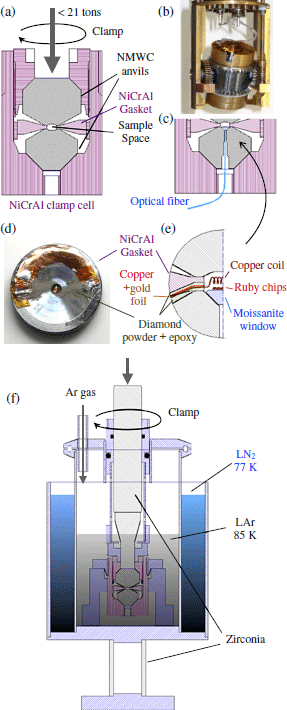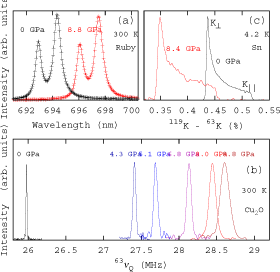Development of Space Efficient Opposed-Anvil
High-Pressure Cell: Application to Optical and
NMR measurements up to 9 GPa
Takigawa, Yagi, and Uwatoko Groups
Application of pressure often leads to the discovery of a new state of matters. In fact pressure-induced quantum phase transitions have been extensively studied in strongly correlated electron systems, such as transition metal oxides and heavy electron materials. Generally, however, one has to compromise between demands for larger sample space and higher pressure. Certain volume-sensitive experimental methods, such as nuclear magnetic resonance (NMR) providing microscopic information on ordering and fluctuations of correlated electrons, have been performed using a piston-cylinder-type pressure cell equipped with sufficiently large sample space of the order of 100 mm3. However, the upper pressure limit such a cell can reach is less than 4 GPa. On the other hand, much higher pressure beyond 10 GPa can be generated by a Bridgeman-type cell or a diamond-anvil-cell. But the available space is 1 mm3 or less.

Fig.1. (a) The cross sectional view of the high-pressure clamp cell. (b) The whole cell can be mounted on an geared two-axis goniometer for arbitrary alignment of the sample in magnetic field. (c) shows the setting for optical measurements, installed with a modified anvil attached with a moissanite (SiC) window and a optical fiber. (d) shows the NMR coil and wire setting on the gasket with the enlarged view shown in (e). (f) The cross sectional view of the argon loading system. Ar gas is liquified by the liquid nitrogen in the outer pot. Then the load is transmitted through the rod made of alumina-zirconia composite ceramics, which has low thermal conductivity.

Fig.2. Spectra of manometers at various pressure values in Ar medium. (a) Room temperature ruby fluorescence spectra at ambient pressure and at 8.8 GPa. (b) 63Cu-NQR spectra of Cu2O at 300 K. (c) 119Sn-NMR spectra of metallic β-Sn at 4.2 K. Since β-Sn has a tetragonal crystal structure, the NMR spectra are broadened by the axial anisotropy of the Knight shift. The peak of the spectra represents the Knight shift for the field in the ab-plane.
We have developed a new type of opposed-anvil pressure cell shown in Fig. 1, which can be used to generate pressure up to 9 GPa over a volume of 7 mm3 with the total cell size of φ29 mm x 41mm [1]. The pair of anvils is made of non-magnetic WC alloy (Fujilloy MF10). The gasket and the clamp cell are made of non-magnetic 56Ni-40Cr-4Al alloy. We have examined more than 40 different shapes and materials of gasket to optimize the available pressure and volume. Our cell has three advantageous features: (1) A transparent moissanite window can be attached for optical measurements (Fig. 1c). We measured the fluorescence from ruby for accurate determination of pressure. (2) The compact size of the cell allows arbitrary rotation of the whole cell by a two-axis goniometer to achieve precise alignment of a single crystal sample in a superconducting magnet (Fig. 1b). (3) We can use argon as the pressure transmitting medium. Ar is a soft molecular solid at high pressure, providing highly hydrostatic environment (Fig. 1f).
In order to establish the convenient pressure scale for NMR experiments, we have measured precise pressure and temperature dependences of the nuclear quadrupole resonance (NQR) frequency of Cu2O and the NMR Knight shift of Pt and Sn metals. The pressure values are determined in-situ by the fluorescence from ruby as shown in Fig. 2. The sharp spectra in Fig. 2 indicate good homogeneity of the pressure.
References
- K. Kitagawa, H. Gotou, T. Yagi, A. Yamada, T. Matsumoto, Y. Uwatoko, and M. Takigawa, J. Phys. Soc. Jpn. 79 024001 (2010).
